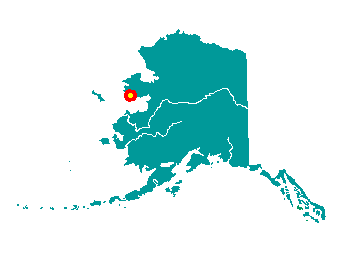Nome was built along the Bering Sea, on
the south coast of the Seward Peninsula, facing Norton Sound. It lies
539 air miles northwest of Anchorage, a 75-minute flight. It lies 102
miles south of the Arctic Circle, and 161 miles east of Russia. It lies
at approximately 64░ 30' N Latitude, 165░ 25' W Longitude (Sec. 26,
T011S, R034W, Kateel River Meridian). The community is located in the
Cape Nome Recording District. The area encompasses 14 sq. miles of land
and 9 sq. miles of water.
 Malemiut,
Kauweramiut and Unalikmiut Eskimos have occupied the Seward Peninsula
historically, with a well-developed culture adapted to the environment.
Around 1870 to 1880, the caribou declined on the Peninsula and the
Eskimos changed their diets.
Malemiut,
Kauweramiut and Unalikmiut Eskimos have occupied the Seward Peninsula
historically, with a well-developed culture adapted to the environment.
Around 1870 to 1880, the caribou declined on the Peninsula and the
Eskimos changed their diets.
Gold discoveries in the Nome area had been reported as far back as
1865 by Western Union surveyors seeking a route across Alaska and the
Bering Sea. But it was a $1500-to-the-pan gold strike on tiny Anvil
Creek in 1898 by three Scandinavians, Jafet Lindeberg, Erik Lindblom,
and John Brynteson, that brought thousands of miners to the "Eldorado."
Almost overnight an isolated stretch of tundra fronting the beach was
transformed into a tent-and-log cabin city of 20,000 prospectors,
gamblers, claim jumpers, saloon keepers, and prostitutes. The
gold-bearing creeks had been almost completely staked, when some
entrepreneur discovered the "golden sands of Nome." With nothing more
than shovels, buckets, rockers and wheel barrows, thousands of idle
miners descended upon the beaches. Two months later the golden sands had
yielded one million dollars in gold (at $16 an ounce). A narrow-gauge
railroad and telephone line from Nome to Anvil Creek was built in 1900.
By 1902 the more easily reached claims were exhausted and large mining
companies with better equipment took over the mining operations. Since
the first strike on tiny Anvil Creek, Nome's gold fields have yielded
$136 million.
The gradual depletion of gold, a major influenza epidemic in 1918,
the depression, and finally World War II, each influenced Nome's
population. A disastrous fire in 1934 destroyed most of the City.